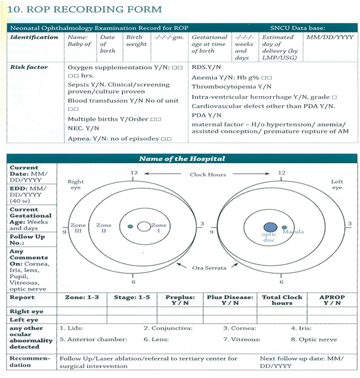Legal issues and follow up of ROP
- Introduction...
- 1. Learning object...
- 2. Legal implicati...
- 3. Proper communic...
- 4. Consent form...
- 5. Proper document...
- 6. Proper document...
- 7. Checklists...
- 8. Importance of f...
- 9. Support system...
- 10. Key messages...
 |
 |
Introduction
DR. J. KUMUTHA
MD, DCH
Professor & Head
Department of Neonatology
Saveetha Medical College
Thandalam, Chennai
1. Learning objectives
► To know about the
♦ Legal issues that can arise
♦ Prevention of legal problems
♦ Importance of follow up
2. Legal implications
► Legal issues could arise due to
♦ Poor communication
♦ Poor documentation
♦ Complications of the procedure
♦ Lack of follow up
3. Proper communication

4. Consent form
► A consent form should include
♦ The details of nature of disease
♦ Possible side-effects
♦ Complications of the treatment
♦ At least two languages (simple understandable terms)
► The same must be communicated verbally to the parents
5. Proper documentation
► The discharge summary must contain
♦ The findings of the first screening, the date and place
for follow-up/ first screening
♦ Advice regarding ROP screening preferably in the local
language
♦ The case record must contain the details of the
screening and treatment
6. Proper documentation

7. Checklists
► Legal problems can be reduced by a considerable extent
only through a system of multiple levels of checks
► Assigning roles and responsibility to each personnel
(screening line list, treatment and follow up)
8. Importance of follow-up
► Follow up examination should be individualized
► It depends on the severity, treatment received and
regression of findings
► It is absolutely necessary that the neonate undergoes
serial examinations till the retina is fully mature
► Assessment for visual acuity and squint is continued into
childhood
9. Support system
► SNCU/ RBSK team- Paediatrician/ Follow - up nurse/
Optometrist/ DEO
► Trained Ophthalmologist
► Community level – ANM/ ASHA/ AWW
► Screening facility should made available at all SNCUs
► Treatment facility at select SNCUs
► Availability of early access to treatment
► Social and educational support
10. Key messages
► Screening for ROP has to be done at the right time to
prevent progression to severe forms
► Multiple levels of checks and parents education will
ensure follow-up thus avoiding complications and legal issues
► Linking with various health functionaries is very crucial
for the success of the ROP programme
